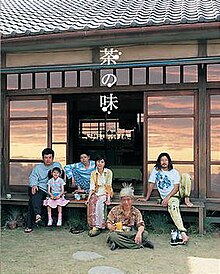The Taste of Tea
| The Taste of Tea (茶の味 Cha no Aji) | |
|---|---|
 The Taste of Tea poster | |
| Directed by | Katsuhito Ishii |
| Written by | Katsuhito Ishii |
| Produced by | Kazuto Takida Kazutoshi Wadakura |
| Starring | Tadanobu Asano Takahiro Sato Maya Banno Satomi Tezuka Tomokazu Miura Tatsuya Gashuin Anna Tsuchiya Rinko Kikuchi |
| Cinematography | Kosuke Matushima |
| Edited by | Katsuhito Ishii |
| Music by | Little Tempo |
| Distributed by | Grasshoppa (Japan) Viz Media (USA) |
Release date | July 17, 2004 |
Running time | 143 min. |
| Country | Japan |
| Language | Japanese |
The Taste of Tea (茶の味, Cha no Aji) is the third film by Japanese writer and director Katsuhito Ishii. The film has been referred to as a "surreal" version of Ingmar Bergman's Fanny and Alexander. It was a selection of the Cannes Film Festival.[1]
Synopsis
The film is concerned with the lives of the Haruno family, who live in rural Tochigi Prefecture, the countryside north of Tokyo. Nobuo is a hypnotherapist. He teaches his son, Hajime, Go. Hajime becomes an excellent Go player, but he has a rough time with girls and puberty. Yoshiko refuses to be an average housewife and works on animated film projects at home. She uses assistance from grandfather Akira, an eccentric old man who is a former animator and occasional model.
Eight-year-old Sachiko periodically sees a silent, giant-size double of herself which mimics or benignly watches her. She contemplates ways to rid herself of it. Uncle Ayano is a sound engineer and record producer who comes to stay for a visit. He engages in inward reflection, seeks closure regarding an old relationship, and recounts a childhood experience — a tale that influences Sachiko and ties into later events.
Cast
- Tomokazu Miura - Nobuo Haruno - father
- Satomi Tezuka - Yoshiko Haruno - mother
- Maya Banno - Sachiko Haruno - daughter
- Takahiro Sato - Hajime Haruno - son
- Tadanobu Asano - Ayano Haruno - uncle
- Tatsuya Gashuin - Akira Todoroki - grandpa
- Tomoko Nakajima - Akira Terako
- Ikki Todoroki - Himself
- Anna Tsuchiya - Aoi Suzuishi
- Kenichi Matsuyama - Matsuken/The man in the red shirt
- Hideaki Anno - Kasugabe
- Rinko Kikuchi - Yuriko Kikuchi
- Ryo Kase - Rokutaro Hamadayama
- Kenji Mizuhashi - Maki Hoshino
Awards
- Audience Award - 2004, Entrevues Film Festival
- Grand Prix - 2004, Entrevues Film Festival
- Best Feature Film - 2004, Hawaii International Film Festival
- Best New Actress (Anna Tsuchiya) - 2004, Hochi Film Awards
- Orient Express Award - 2004, Festival de Cine de Sitges (Special Mention)
- Audience Award - 2005, Dejima Japanese Film Festival
- Best Asian Film - 2005, Fant-Asia Film Festival
- Fantasia Ground-Breaker Award - 2005, Fant-Asia Film Festival (3rd Place)
- Audience Award - 2005, New York Asian Film Festival
- Best New Actress (Anna Tsuchiya) - 2005 Kinema Junpo Awards
- New Talent Award (Anna Tsuchiya) - 2005, Mainichi Film Award
- Festival Prize - 2005, Yokohama Film Festival
References
- ^ "Midnight Eye interview: Rinko Kikuchi". Retrieved 2007-02-14.
Sources
- 茶の味 (in Japanese). Japanese Movie Database. Retrieved 2008-01-05.
External links
